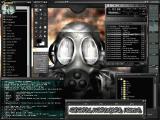

Using the Linux Fdisk Command and Linux Parted Command to Do Hard Disk Partitioning – Red Hat Linux
Posted by admin in Linux on 11 25th, 2010 | no responses
Clyde E. Boom asked:
The Linux fdisk and parted commands are both used to start “utility” programs that are used to do hard disk partitioning tasks.
Understanding Linux Hard Disk Partitions and Filesystems
Prior to installing the Linux operating system on a hard disk, a partition of some type is created on the disk. This is typically done when running the installation routine, but can also be done by using the fdisk or parted commands.
After being created, the Linux partition is assigned a filesystem type, and then formatted..
After being formatted, the Linux OS and the other software components, such as the GNU commands, servers, a desktop and other components are installed on it.
You can have the installation routines of most Linux distributions do all of these for you.
However, as a Linux System Administrator you will need to modify Linux partitions after the OS has been installed and for this, you need to run fdisk (for most tasks) or parted (for more complex tasks).
The Linux fdisk Command / Utility
The fdisk command is a GNU command that is used to do tasks such as create and modify partitions and assign a filesystem. fdisk stands for “fixed disk”, as in “hard disk”.
This utility is a program that is installed on virtually all Linux distributions.
The Linux parted Command / Utility
This command is an extremely powerful disk partitioning utility that can do much more than fdisk, such as resize and copy a partition. The word parted stands for “partition editor“.
This command is a program that is not always installed on all distributions. You may need to download and install it to be able to use it on a system.
The Linux hard disk partitioning concepts and commands covered here apply to: Fedora, Red Hat, Ubuntu, Slackware, and Debian Linux – and ALL other Linux distributions.
Caffeinated Content for WordPress
The Linux fdisk and parted commands are both used to start “utility” programs that are used to do hard disk partitioning tasks.
Understanding Linux Hard Disk Partitions and Filesystems
Prior to installing the Linux operating system on a hard disk, a partition of some type is created on the disk. This is typically done when running the installation routine, but can also be done by using the fdisk or parted commands.
After being created, the Linux partition is assigned a filesystem type, and then formatted..
After being formatted, the Linux OS and the other software components, such as the GNU commands, servers, a desktop and other components are installed on it.
You can have the installation routines of most Linux distributions do all of these for you.
However, as a Linux System Administrator you will need to modify Linux partitions after the OS has been installed and for this, you need to run fdisk (for most tasks) or parted (for more complex tasks).
The Linux fdisk Command / Utility
The fdisk command is a GNU command that is used to do tasks such as create and modify partitions and assign a filesystem. fdisk stands for “fixed disk”, as in “hard disk”.
This utility is a program that is installed on virtually all Linux distributions.
The Linux parted Command / Utility
This command is an extremely powerful disk partitioning utility that can do much more than fdisk, such as resize and copy a partition. The word parted stands for “partition editor“.
This command is a program that is not always installed on all distributions. You may need to download and install it to be able to use it on a system.
The Linux hard disk partitioning concepts and commands covered here apply to: Fedora, Red Hat, Ubuntu, Slackware, and Debian Linux – and ALL other Linux distributions.
Caffeinated Content for WordPress
Related Posts

No Comments »
No comments yet.
RSS feed for comments on this post. TrackBack URL












